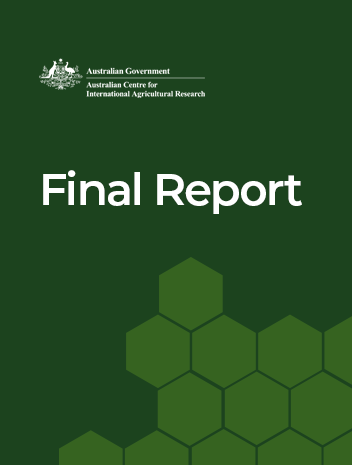- HomeHome
-
About ACIAR
- Our work
- Our people
-
Corporate information
- ACIAR Audit Committee
- Commission for International Agricultural Research
- Policy Advisory Council
- Agency reviews
- Executive remuneration disclosure
- Freedom of information (FOI)
- Gifts and benefits register
- Information publication scheme
- List of new agency files
- Contracts
- Legal services expenditure
- Privacy impact assessment register
- Commonwealth Child Safe Framework
- Benefits to Australia
- Careers
- 40 years of ACIAR
-
What we do
- Programs
- Cross-cutting areas
- Resources
- Where we work
-
Funding
- Research projects
- Fellowships
-
Scholarships
- John Allwright FellowshipScholarships to study in Australia for ACIAR partner country scientists to have Australian postgraduate qualifications
- ACIAR Pacific Agriculture Scholarships and Support and Climate Resilience Program
- Alumni Research Support Facility
- Publications
- News and Outreach
Project final report
Soil-based challenges for cropping in Shan State (nutrient acquisition) - Final Report
Date released
15 May 2023
ISBN
978-1-922983-06-0
Publication Code
FR2023-014
Overview
This project, led by Southern Cross University in Australia and the Department of Agriculture (DoA; Land Use Division) in Myanmar, aimed to investigate the use of hedge-rows and contour banks to minimise erosion on sloping lands; demonstrate the use of living legume cover crops in maize fields to minimise erosion; investigate the use permanent pastures to replace the traditional fallow phase; and demonstrate the benefits of new soybean varieties and rhizobia for improved soybean production.
Agricultural productivity in the Shan state of Myanmar is constrained by many factors, in particular, soil constraints including high phosphorus fixation and generally low soil fertility due to removal of nutrients in residues (especially relevant for potassium). Erosion of topsoil also occurs during the cropping phases of rotations and in the fallow phase used in traditional shifting cultivation. Owing to population pressure, intensification of agriculture has resulted in traditional 6-10-year fallow phases being reduced to 1-2 years, during which time the land does not recover, and severe erosion occurs.
The COVID-19 pandemic and a military coup hindered plans to conduct a more thorough investigation of soil constraints and solutions with farmers and other stakeholders in Shan State. While the field trials in this small research activity have limited statistical power, there is sufficient evidence to suggest that hedgerow systems or cover cropping in maize crops could result in improved yield, reduced erosion and can benefit soil fertility.



